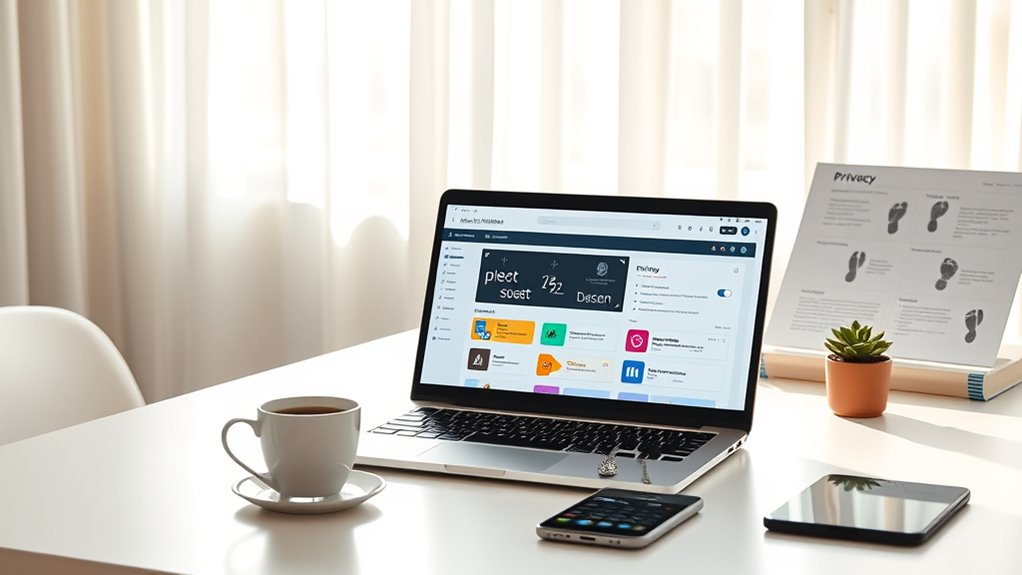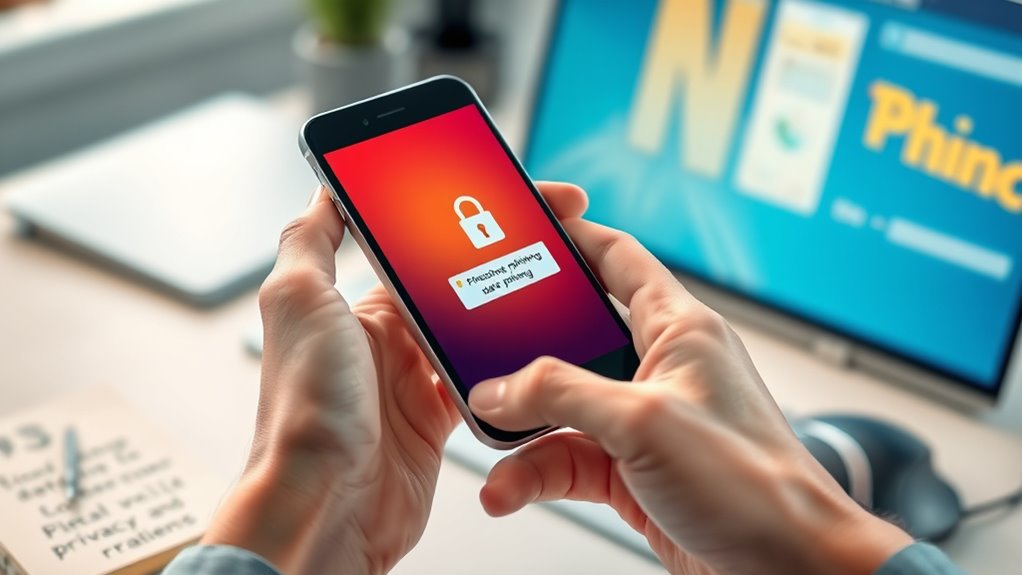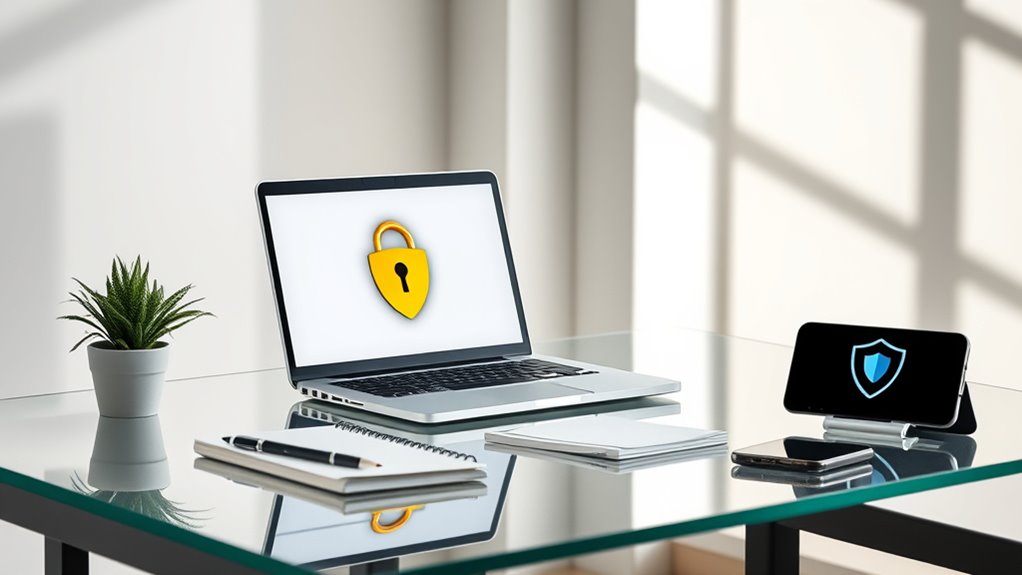To improve your privacy hygiene, start by understanding your digital footprint and regularly reviewing your social media settings to control who sees your information. Manage app permissions, use strong passwords, and keep old accounts clean to minimize your data exposure. Stay vigilant against phishing scams and stay informed about your privacy rights and updates. Keeping these practices in check helps protect your personal info—more tips await to support your data detox journey.
Key Takeaways
- Regularly review and adjust privacy settings on social media to control who can see your information.
- Remove outdated posts, photos, and unused accounts to minimize your digital footprint.
- Manage app permissions by restricting access to location, camera, and microphone, and revoke unnecessary permissions.
- Use strong, unique passwords for each account and update them regularly to enhance security.
- Stay informed about privacy laws, monitor data breaches, and be cautious of phishing scams to protect your personal data.
Understanding Your Digital Footprint

Have you ever wondered what your online presence says about you? Your digital footprint is the trail you leave behind every time you go online—whether you post on social media, comment on websites, or shop online. It’s a collection of all your digital activities that shape your online reputation. Even if you think you’re private, information about you can still be accessible and visible. Understanding your digital footprint helps you see how your actions impact how others perceive you. The more aware you are, the better you can control what’s visible and protect your online reputation. Remember, your digital footprint grows with each click, so managing it is key to maintaining your privacy and a positive online image. Being mindful of content sharing practices can further help you minimize unwanted exposure and safeguard your personal data. Recognizing your online behavior patterns can also guide you in making more conscious decisions about your digital interactions. Additionally, being aware of the vibrational energy you project through your online activity can influence your overall online presence and reputation. Incorporating privacy settings into your online profiles is essential for controlling who can see your information and reducing unnecessary exposure. Moreover, understanding the local legal landscape can help you stay informed about regulations that protect your privacy rights online.
Auditing Your Privacy Settings on Social Media

You should regularly review your social media privacy settings to control who sees your information. Limit access by narrowing your audience and removing any unnecessary data that could expose too much about you. Taking these steps helps protect your privacy and keeps your online presence secure. Additionally, understanding cookie consent management can help you make informed decisions about your data sharing preferences. Being aware of the security vulnerabilities in new payment technologies can also help you stay vigilant against potential threats. Managing your privacy preferences effectively is essential for maintaining your personal security online. Moreover, being informed about Gold IRA rollovers can help you safeguard your retirement investments against economic uncertainties. Incorporating knowledge about Fokos can further enhance your understanding of maintaining privacy and security in digital spaces.
Review Privacy Options
When was the last time you reviewed your privacy settings on social media? It’s a good idea to check them regularly. Start by reading each platform’s privacy policy to understand how your data is collected and used. Look for options related to data encryption, which protects your information during transmission. Verify your settings limit who can see your posts, personal info, and activity. Take note of any permissions you’ve granted apps or third parties, and revoke those you no longer trust. Updating these options helps you control your digital footprint and reduces exposure to unwanted sharing. Regularly reviewing and adjusting your privacy settings keeps your information safer and ensures you’re in control of your online presence. Incorporating practices like privacy awareness can also help reduce stress related to online privacy concerns. Additionally, understanding how jet boats operate and their safety features can remind you of the importance of operational security in different contexts. Staying informed about security features in your devices and accounts can further enhance your online safety. Being aware of nutritional insights from apple juice can also encourage healthier choices in your diet.
Limit Audience Access
Ever wonder who can see your social media posts and personal info? You can manage access control by reviewing your privacy settings regularly. Limit your audience to trusted friends rather than everyone. This reduces unnecessary data exposure and helps with data minimization.
Additionally, privacy policies provided by platforms outline how your data is handled and what controls you have over your information.
Here’s a quick guide:
| Setting | Who Can See It? |
|---|---|
| Profile visibility | Only friends or custom groups |
| Post audience | Friends, friends of friends |
| Tag review | Approves tags before they appear |
| Location sharing | Only you or trusted contacts |
Adjust these options to control who accesses your data. Regular audits keep your privacy tight and prevent strangers from viewing your personal info. Remember, better access control means less data risk.
Remove Unnecessary Data
Regularly reviewing and cleaning up your social media data helps guarantee your privacy stays intact. Start by removing any unnecessary posts, photos, or personal details you no longer need. This reduces the risk of exposing sensitive information. Check your privacy settings and limit who can see your data to maintain control. Enable data encryption features where available to protect your information during storage and transmission. Practice secure browsing by avoiding suspicious links and using secure networks, which minimizes data leaks. Clearing out outdated or irrelevant data ensures only current, relevant information is accessible. Staying vigilant about your digital footprint helps prevent potential privacy breaches and keeps your online presence safer. Regular audits help you stay in control of your data and preserve your privacy. Additionally, understanding website creation essentials can help you establish a secure online environment from the ground up. Developing a strong digital identity can further enhance your online security and privacy awareness. Incorporating privacy-conscious habits into your routine also contributes significantly to maintaining your online safety. For example, choosing secure passwords and updating them regularly adds another layer of protection against unauthorized access. Being aware of the types of headphone jacks can also prevent damage when connecting devices, ensuring your equipment remains functional and secure.
Managing Permissions and App Access

Managing permissions and app access is essential for maintaining your privacy because it controls what information apps can see and use. By reviewing app permissions regularly, you limit unnecessary data sharing that could expose sensitive details. For example, deny location access to apps that don’t need it or restrict camera and microphone permissions unless essential. This way, you prevent apps from collecting more data than they need. Keep in mind that granting broad permissions can lead to data sharing with third parties or misuse of your information. Staying vigilant about app permissions empowers you to protect your privacy and minimize potential risks. Regularly checking and adjusting these settings ensures your data stays under your control. Additionally, understanding Mazda Tuning concepts can help you recognize how vehicle data might be accessed or shared through connected apps, further emphasizing the importance of permission management. Being aware of privacy settings enables you to customize access and maintain better control over your personal information. For added security, consider permissions management strategies to better safeguard your digital footprint. Utilizing security features provided by apps can further enhance your privacy protections.
Clearing Out Old Accounts and Data

Old accounts and outdated data can pose significant privacy risks if left unattended. When you deactivate accounts you no longer use, you reduce the chance of your information being accessed or misused. Account deactivation is a simple way to disconnect yourself from services you no longer need. If you want to keep some data for future reference, consider data archiving—saving the relevant information securely offline or in a protected cloud. This way, you preserve important details without leaving active accounts vulnerable. Regularly reviewing your digital footprint helps you stay in control of your personal information. Clearing out old accounts and properly archiving data minimizes your exposure to breaches and identity theft, making your online presence safer and more manageable.
Using Strong and Unique Passwords

Creating strong, complex passwords makes it harder for hackers to access your accounts. Use unique combinations of letters, numbers, and symbols for each site. This way, even if one password is compromised, your other accounts stay protected.
Craft Complex Passwords
Crafting complex passwords is vital for protecting your digital life. Strong passwords increase password complexity, making it harder for hackers to guess or crack them. Avoid common words, personal info, or simple patterns. Instead, combine uppercase and lowercase letters, numbers, and symbols to create unpredictable sequences. Remember, a complex password isn’t just about length but also about variety. Good password management involves using different passwords for each account to prevent a single breach from compromising everything. Consider using a password manager to securely store and organize your complex passwords. This way, you won’t have to memorize every detail, reducing the temptation to reuse or write down passwords insecurely. Prioritizing password complexity and management is a vital step toward safeguarding your privacy online.
Use Unique Combinations
To effectively protect your online accounts, it’s essential to use strong and unique passwords for each one. This minimizes risks if a site experiences a data breach, especially since privacy laws increasingly mandate data encryption standards. Creating unique combinations means avoiding reuse across platforms, reducing the chance of a domino effect if one account is compromised. Imagine a password that mixes uppercase, lowercase, numbers, and symbols—then customize it for every login. Picture a password manager securely storing your complex passwords, so you don’t have to memorize them. Think of each account as a vault with a distinct key, safeguarding your data and respecting privacy laws. This strategy makes it harder for hackers to access multiple accounts, ensuring your digital life stays private and protected.
Recognizing and Avoiding Phishing and Scams

Since scammers often disguise their messages to appear legitimate, it’s crucial to learn how to recognize common signs of phishing and scams. Be cautious of emails asking for personal information or urgent actions, as these are common tactics in email scams. Look for misspellings, suspicious sender addresses, or generic greetings, which can indicate a scam. Avoid clicking links or downloading attachments from unknown sources. Scammers aim to steal your data and commit identity theft, so double-check URLs and verify requests through official channels. Remember, legitimate companies rarely ask for sensitive info via email. Staying alert helps prevent falling victim to scams that could compromise your privacy and lead to serious consequences like financial loss or identity theft.
Staying Informed About Privacy Rights and Updates

Staying informed about your privacy rights and recent updates is essential for maintaining control over your personal data. By keeping up with privacy legislation, you can understand your rights and how companies must protect your information. Staying aware of data breach notifications ensures you’re alert to any security incidents that may impact you. To stay current, consider:
Stay informed on privacy rights and data breaches to protect your personal information effectively.
- Subscribing to official privacy regulation updates
- Following trusted privacy advocacy groups
- Checking government websites for new data protection laws
- Monitoring news about major data breaches and their implications
This knowledge helps you respond proactively, request necessary changes, and hold organizations accountable. Regular updates empower you to navigate the evolving landscape of privacy rights confidently and protect your personal information effectively.
Frequently Asked Questions
How Often Should I Review My Privacy Settings?
You should review your privacy settings at least once every three to six months. Regularly updating your social media privacy settings helps protect your personal information, while good password management prevents unauthorized access. If you notice any suspicious activity or platform updates, review your settings immediately. Staying proactive guarantees your data stays private and secure, giving you peace of mind and better control over who sees your information online.
What Are Signs My Data Might Be Compromised?
If your data might be compromised, watch for signs like unexpected emails or messages, which could be phishing scams. You might notice unfamiliar account activity or strange charges, indicating identity theft. Sudden password changes or alerts from your accounts are also warning signs. Stay vigilant, review your accounts regularly, and act quickly if you spot anything suspicious to protect your personal information from further risks.
How Can I Securely Delete Old Online Accounts?
To securely delete old online accounts, start with an account cleanup by locating all your unused profiles. Use the account’s settings to find the data deletion option and follow the steps carefully. If available, request account deletion through customer support. Always verify that your data is fully erased by checking for confirmation emails or links. Regularly perform data deletion to keep your digital footprint minimal and protect your privacy.
Are VPNS Effective for Protecting My Privacy?
VPNs can boost your privacy by encrypting your internet traffic, but they have limitations and don’t guarantee complete protection. Be aware of privacy myths, like thinking they hide all your activity or mask your identity fully. VPNs are useful tools, but you should also practice good privacy habits, such as avoiding risky sites and using strong passwords. Relying solely on a VPN isn’t enough; combine it with other privacy measures for better security.
How Do I Balance Privacy With Convenience Online?
Balancing privacy with convenience means managing your online habits wisely. You can do this by using strong password management to secure accounts without hassle, adjusting social media privacy settings to stay connected while controlling what you share, and choosing tools that prioritize both ease of use and data protection. By staying intentional about your online activities, you protect your privacy without sacrificing the convenience that makes digital life easier.
Conclusion
By taking these steps, you’re not just protecting your data—you’re reclaiming control over your digital life. Think of your privacy as a garden; with consistent care, it flourishes amidst the chaos. Remember, in the vast landscape of the internet, your vigilance is the guardrail that keeps your personal information safe. Stay proactive, stay informed, and let your privacy hygiene become a habit that shields you from unseen threats.









